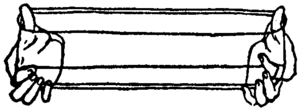Cat's cradle




Cat's cradle is a series of string figures created between two people as a game. The name of the entire game, the specific figures, their order, and the names of the figures vary. Versions of this game have been found in indigenous cultures all over the world—from the Arctic to the Equatorial zones. In some regions of the US, this game is also known as Jack in the Pulpit.[4]
How to play
The game begins with the first player wrapping a loop of string around the hand (around the fingers or wrists) and taking one side of the string and circling the hands again. Then this player performs the last two moves of Opening A: taking the string which runs on the inside of the left arm onto the first finger of their right hand, then, reaching through the triangle created, the loop on the inside of the right hand is taken onto the first finger of the left hand).
The aim of the game is to make a set of figures including the "cat's cradle". This is created by two sets of crossed string between both hands. A second player grasps each cross horizontally using the thumb and first fingers, pulls these outwards, down under the line which runs below the crosses from the first players wrists, and back up. The first player lets go of the figure and the second player stretches it open by bringing apart the thumbs and fingers. This figure is the "diamonds". A series of other alterations produce more figures, some of which lead back to the diamonds while some are dead ends and cannot be transformed. (Some say that "diamonds" is the cat's cradle from the game title, while others insist it's only the game title, and not any figures.)
This game is very simple and is always started with the above opening. After that one mostly pinches the xs and wrap them around the outside strings. The other moves tend to need a little more practice. Some of these advanced figures include the Candles, the Manger, Knitting Needles, and the Scorpion.
The game may be played solo, as is done in Japan and Hawaii.[5]
History
The origin of the name "cat's cradle" may have come from a corruption of cratch-cradle, or manger cradle[nb 1][nb 2] (though this derivation is disputed by the OED). The French word for manger is crèche, and cattle feed racks are still known as cratches. It may, as in Europe, have to do with the "manger cradle" in the Nativity of Jesus.[3][2]
In an 1858 Punch cartoon[6] it is referred to as "scratch cradle", a name supported by Brewer's 1898 Dictionary.[7] Different cultures have different names for the game, and often different names for the individual figures. (For instance, in Russia the whole game is simply called "the game of string"[8] and the "diamonds" pattern a "carpet", with names like "field", "fish" and "sawhorse" for all other figures. The cat isn't ever mentioned, but the cradle is, though it's the initial figure that is called so.)[citation needed]
The game may have originated in China and Korea.[9]
In China cat's cradle is called kang sok (English: well rope),[10] or catch cradle.[8]
"The Navajo say that their forefathers were taught to play web weaving games by the Spider People, while the Zuni declare...that the game was given to them by Grandmother Spider."[11]
A character in Joanna Russ's 1975 novel The Female Man calls cat's cradle, "not only the universal symbol of peace, but a pretty good game, too."[12]
World record
Geneva Hultenius, Maryann DiVona, and Rita Divona completed 21,200 cat's cradles in 21 hours in Chula Vista, California between August 17-18, 1974. The Guinness Book of World Records reported it as a world record in the 1975 and 1976 editions.[13]
Jane Muir and Robyn Lawrick completed 22,700 cat's cradles in 21 hours at Calgary Market Mall, Alberta, Canada on August 25, 1976.[14]
Notes
- ↑ "Nares, under Cratche, an archaic word for manger, deems it to be the origin of the name of this game, which, however, he calls scratch-cradle. But it clearly, he says, meant originally cratch-cradle, the manger which held the Holy Infant as a cradle..."[3]
- ↑ "This opens to us the meaning of a childish game, corruptly called scratch-cradle, which consists in winding a packthread double round the hands, into a rude representation of a manger, which is taken off by the other player on his hands, so as to assume a new form, and thus alternately for several times, always changing the appearance. The art consists in making the right changes. But it clearly meant originally the cratch-cradle; the manger that held the Holy Infant as a cradle."[2]
References
- ↑ 1.0 1.1 1.2 Squareman, Clarence (1916). My Book of Indoor Games, Gutenberg.org.
- ↑ 2.0 2.1 Nares, Robert. A Glossary: Or, Collection of Words, Phrases, Names, and Allusions to Customs, Proverbs, Etc., p. 203. London: Gibbings and Company, Limited (1901).
- ↑ 3.0 3.1 Taylor, E.S. "Cats-Cradle", pp. 412–422 of Notes and Queries: A Medium of Inter-communication for Literary Men, Artists, Antiquaries, Genealogists, Etc., pp. 421–422, Vol. 11 (January—June, 1855). London: George Bell (1855).
- ↑ Anderson, John P. (2010). Joyce's Finnegans Wake: The Curse of Kabbalah, Volume 4, p.301. ISBN 978-1-59942-810-9.
- ↑ Gryski, Camilla (1985). Many Stars & More String Games, pp. 66–72. Tom Sankey, illustrator. ISBN 0-688-05792-6.
- ↑ "Snowed Up", John-Leech-Archive.org.UK.
- ↑ "Scratch Cradle", Bartleby.com.
- ↑ 8.0 8.1 Buchanan, Andrea J. and Peskowitz, Miriam (2007). The Daring Book for Girls, p.277. ISBN 978-0-06-147257-2.
- ↑ (1989). Anthroquest: the L.S.B. Leakey Foundation news, Issues 39–46, p.17. The Foundation.
- ↑ Jayne, C. F. (1906/1962). String Figures and How to Make Them, p.324. ISBN 978-0-486-20152-8.
- ↑ Allan and Paulette Macfarlan (1958). Handbook of American Indian Games, p.189. ISBN 978-0-486-24837-0.
- ↑ Russ, Joanna (1975/2000). The Female Man, p.23. ISBN 978-0-8070-6299-9.
- ↑ McWhirter, Norris and McWhirter, Alan Ross (1975). Guinness Book of World Records, 1976, p.459. Revised. ISBN 978-0-8069-0014-8.
- ↑ McWhirter, Ross (1983). Guinness Book of World Records 1979, p.453. ISBN 978-0-8069-0130-5.
External links
| Wikimedia Commons has media related to String figures. |
- "Cat's Cradle String Game for Two", Alysion.org.
- "How to Do Cat's Cradle: Step-by-step pictures and instructions", IfYouLoveToRead.com.